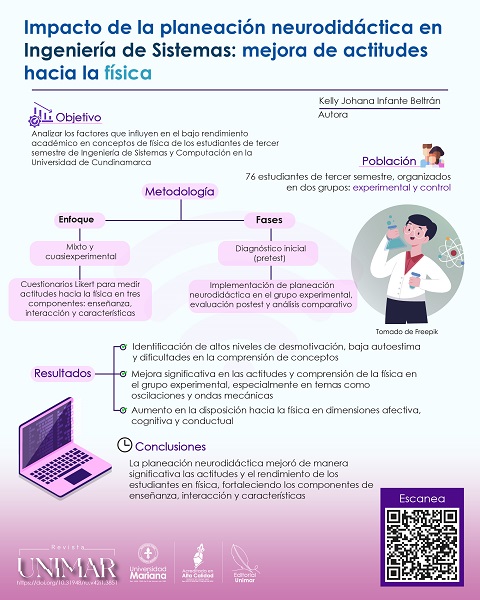Impact of neurodidactic planning in Systems Engineering: improving attitudes towards physics
DOI:
https://doi.org/10.31948/ru.v42i2.4293Keywords:
neuroeducation, neurodidactics, student attitudes, physics education, higher educationAbstract
To analyze the factors that influence the low academic performance of third semester students of Systems and Computer Engineering of the Universidad de Cundinamarca in physics concepts. The research was developed under a mixed approach and quasi-experimental design. For the collection of information, Likert scale questionnaires were used to measure attitudes towards physics, covering three components: teaching, interaction and characteristics. The methodology was structured in four phases: initial diagnosis through a pretest; implementation of the neurodidactic plan in the experimental group; posttest evaluation of attitudes; and comparative analysis of the groups. We worked with 76 students, organized in two groups: experimental and control. Through the application of the instruments it was possible to identify high levels of demotivation, low self-esteem and difficulties in understanding concepts. In addition, the data were compared to identify patterns in those with low performance. The analysis of the information allowed us to formulate the following hypothesis: the implementation of neurodidactic planning significantly improves students’ attitudes and understanding of physics concepts such as oscillations and mechanical waves. The results show a significant improvement in the affective, cognitive and behavioral dimensions of the students; therefore, they show a greater disposition towards physics. Neurodidactic planning generated significant improvements in students’ attitudes towards physics, especially in the components of characteristics, interactions and teaching.
Author Biography
Kelly Johana Infante Beltrán, Universidad de Cundinamarca
Doctoranda en Educación e Innovación, UIIX México. Docente investigadora, Universidad de Cundinamarca; integrante del grupo de investigación INGENIUM SUTA, Fusagasugá, Cundinamarca, Colombia.
References
Benavidez, V. V. y Flores, P. R. (2019). La importancia de las emociones para la neurodidáctica. Revista Wimb LU, 14(1), 25-53. https://doi.org/10.15517/wl.v14i1.35935
Briones Cedeño, G. C. y Benavides Bailón, J. (2021). Estrategias neurodidácticas en el proceso enseñanza-aprendizaje de educación básica. ReHuSo Revista Ciencia Humanística y Sociales, 6(1), 72-81. https://doi.org/10.5281/zenodo.5512773
Calatayud Salom, M. A. (2018). Hacia una cultura neurodidáctica de la evaluación. La percepción del alumnado universitario. Revista Iberoamericana de Educación, 78(1), 67-85. https://doi.org/10.35362/rie7813212
Calzadilla, O. O. (2017). La integración de las neurociencias en la formación inicial de docentes para las carreras de la educación inicial y básica: Caso Cuba. Actualidades Investigativas en Educación, 17(2), 1-27. https://doi.org/10.15517/aie.v17i2.28709
Codina, M., Aldana, D., Piédrola, I. y Ramos Regalado, I. (2022). Una estructura neurodidáctica para el desarrollo de las funciones ejecutivas en los adolescentes: ¿Es posible desarrollar el control inhibitorio en el aula? Journal of Neuroeducation, 2(2), 118-129. https://doi.org/10.1344/joned.v2i2.32839
Díaz-Cabriales, A. (2021). La neuroeducación en los programas de formación y profesionalización docente en México. Ciencia y Educación, 5(2), 63-78. https://doi.org/10.22206/cyed.2021.v5i2.pp63-78
Figueroa Molina, R., Bernal Martínez, M. y Thorné Torné, R. (2021). La neurodidáctica como elemento primordial en la formación inclusiva docente. Revista Boletín REDIPE, 10(11), 26-44. https://doi.org/10.36260/rbr.v10i11.1522
Ibáñez-Cubillas, P. (2022). Fatores neurodidáticos no ensino baseado nas TIC: contribuições para a formação de professores. Texto Livre: Linguagem e Tecnologia, 15(5), 1-11. https://doi.org/10.35699/1983-3652.2022.41617
Intriago Plaza, J. R., Mendoza Vélez, O. V., Chávez Rodríguez, W. F. y Ormaza Cevallos, M. G. (2022). Saber para aprender a aprender matemática: Neurodidáctica y estrategias de autorregulación emocional. Educare, 26(extraordinario), 687-702. https://doi.org/10.46498/reduipb.v26iExtraordinario.1674
Muchiut, Á., Vaccaro, P., Pietto, M. y Sánchez, B. (2024). Intervención neurodidáctica sobre las funciones ejecutivas en adolescentes: Neurodidáctica y funciones ejecutivas. Revista de Neuroeducación, 4(2), 149-151. https://revistes.ub.edu/index.php/joned/article/view/42417
Pérez Marrero, N. M. (2023). Dinámica neurodidáctica formación de docentes desde la neuropedagogía. Papeles, 15(29), 86-99. https://doi.org/10.54104/papeles.v15n29.1320
Rodríguez-Cano, S., Cuesta-Gómez, J. L., Delgado-Benito, V. y Fuente-Anuncibay, R. de la. (2022). Educational Technology as a Support Tool for Students with Specific Learning Difficulties-Future Education Professionals' Perspective. Sustainability, 14(10), 6177. https://doi.org/10.3390/su14106177
Salomón Burgos. (2023, 4 de marzo). Al pin al pon a la hija del conde Simón [Video]. YouTube. https://www.youtube.com/watch?v=5CpPb9q7MOA
Sánchez Tallabas, N. E., Valadez Mena, V., Luna García, M. del R. y Valadez Mena, M. E. (2023). Las estrategias neurodidácticas para aprender a aprender. Revista RELEP - Educación y Pedagogía en Latinoamérica, 5(3), 55-72. https://doi.org/10.46990/relep.2023.5.3.1125
Saquicela Richards, C. E. (2022). La neurodidáctica como una herramienta pedagógica en la praxis de los docentes integrales de Educación General Básica Elemental. Revista Científica UISRAEL, 9(1), 117-137. https://doi.org/10.35290/rcui.v9n1.2022.499
Vázquez, A. y Manassero Mas, M. A. (1995). Actitudes relacionadas con la ciencia: una revisión conceptual. Enseñanza de las Ciencias: Revista de Investigación y Experiencias Didácticas, 13(3), 337-346. https://doi.org/10.5565/rev/ensciencias.4254
How to Cite
Downloads

Downloads
Published
Issue
Section
License
Copyright (c) 2024 Revista UNIMAR

This work is licensed under a Creative Commons Attribution 4.0 International License.
Los autores que publiquen en esta revista aceptan las siguientes condiciones:
1. Los autores conservan los derechos de autor y ceden a la revista el derecho de la primera publicación, con el trabajo registrado con la licencia de atribución de Creative Commons, que permite a terceros utilizar lo publicado siempre que mencionen la autoría del trabajo y a la primera publicación en esta revista.
2. Los autores pueden realizar otros acuerdos contractuales independientes y adicionales para la distribución no exclusiva de la versión del artículo publicado en esta revista (p. ej., incluirlo en un repositorio institucional o publicarlo en un libro) siempre que indiquen claramente que el trabajo se publicó por primera vez en esta revista.
3. Se permite y recomienda a los autores publicar su trabajo en Internet (por ejemplo en páginas institucionales o personales) antes y durante el proceso de revisión y publicación, ya que puede conducir a intercambios productivos y a una mayor y más rápida difusión del trabajo publicado (veaThe Effect of Open Access).
| Article metrics | |
|---|---|
| Abstract views | |
| Galley vies | |
| PDF Views | |
| HTML views | |
| Other views | |







